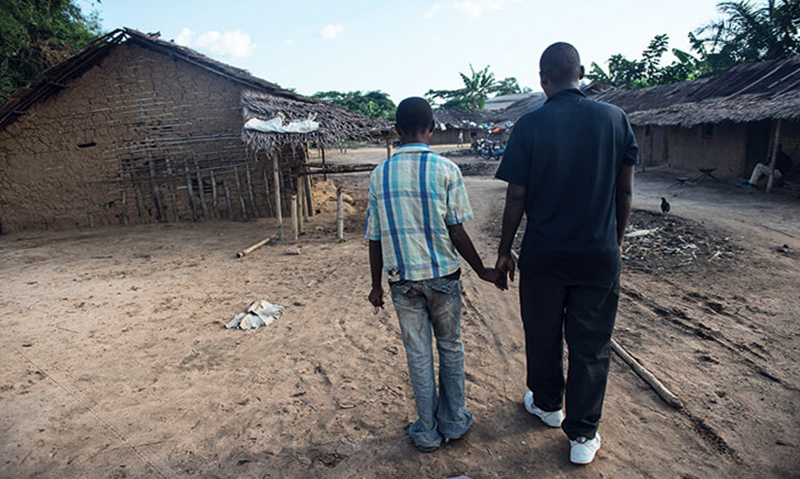
FILARIAL DISEASES

"I depend totally on my wife, she feeds and dresses me, and on my son. After I lost my sight we couldn’t send any of our children to school."
Akoyo
Akoyo’s son guides his father everywhere since he went blind, Democratic Republic of the Congo.
Fisherman Akoyo went blind in 2011, as a result of river blindness. He lives in the remote village of Babagulu in the Democratic Republic of the Congo.
The creeping blindness had begun a year earlier, and it eventually robbed him of his livelihood and the means to send his children to school.
Ironically, Akoyo had once fought against the disease that eventually robbed him of his sight, as a volunteer distributing drugs to prevent transmission of river blindness.
Akoyo’s village is one of many in the region devastated by river blindness, a neglected tropical disease transmitted by the bite of the blackfly. The river nearby makes it a perfect breeding ground for the blackflies that infect people with the filarial worms that cause river blindness.
Community leaders estimate that up to 3% of the community is blind. Akoyo’s son Aito also has the tell- tale nodules on his torso and forehead, some the size of golfballs – painless, but a clear sign that he, too, is infected.
Existing treatments for filarial diseases take years to be effective because they only kill juvenile worms, not the adult worms, which continue to reproduce. Mass drug administration (MDA) programmes, typically using ivermectin, must therefore be repeated once or twice a year for over a decade until the adult worms die of natural causes. Despite many rounds of MDA, the disease has not yet been eliminated and a short-course treatment that kills adult worms and reduces the number of MDA cycles is needed to fulfill this goal. There are also serious safety issues with using ivermectin to treat people infected with loiasis. In addition, suboptimal responses to standard treatment in onchocerciasis patients may be indicators of drug resistance.
- Filarial diseases from parasitic nematode worms are transmitted to humans by blood-sucking insects
- There are three filarial diseases: lymphatic filariasis (LF, also known as elephantiasis), onchocerciasis (also known as river blindness) and loiasis (also known as Loa loa, or African eye- worm)
- Filarial diseases are rarely fatal but inflict hardship and misery on millions of people. Onchocerciasis and lymphatic filariasis cause life-long disabilities such as blindness, severe itching, dermatitis, and swollen limbs and genitals
- Lymphatic filariasis is endemic in 54 countries worldwide
- Onchocerciasis is endemic in 31 African countries
OVER120MILLION
people infected with LF
OVER37MILLION
people infected with onchocerciasis
947MILLION
people at risk of LF
169MILLION
people at risk of onchocerciasis

